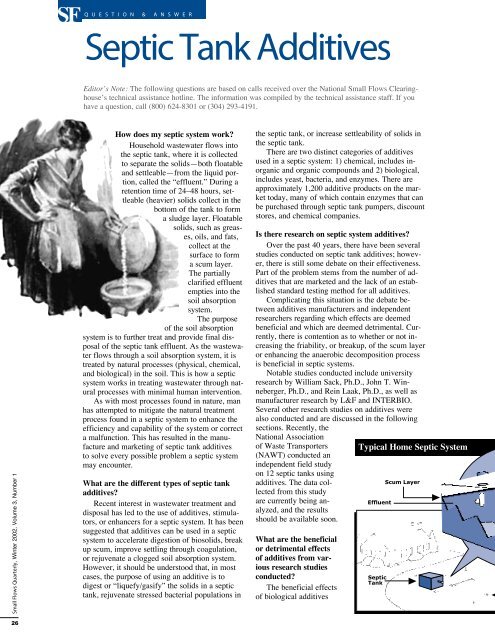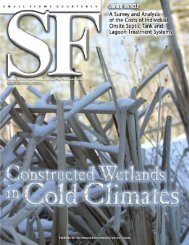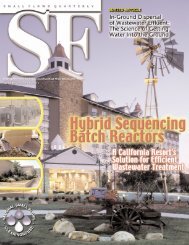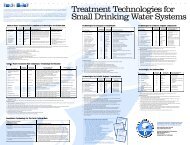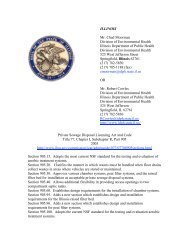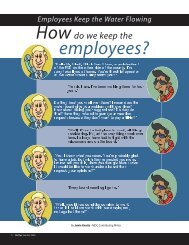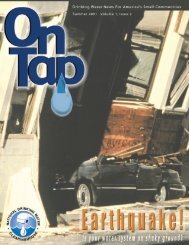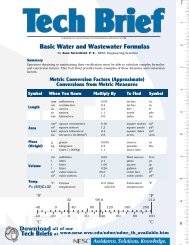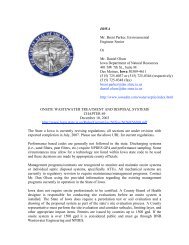Septic tank Additives
Septic tank Additives
Septic tank Additives
- No tags were found...
You also want an ePaper? Increase the reach of your titles
YUMPU automatically turns print PDFs into web optimized ePapers that Google loves.
Q u e s t i o n & A n s w e r<strong>Septic</strong> Tank <strong>Additives</strong>Editor’s Note: The following questions are based on calls received over the National Small Flows Clearinghouse’stechnical assistance hotline. The information was compiled by the technical assistance staff. If youhave a question, call (800) 624-8301 or (304) 293-4191.Small Flows Quarterly, Winter 2002, Volume 3, Number 1How does my septic system work?Household wastewater flows intothe septic <strong>tank</strong>, where it is collectedto separate the solids—both floatableand settleable—from the liquid portion,called the “effluent.” During aretention time of 24–48 hours, settleable(heavier) solids collect in thebottom of the <strong>tank</strong> to forma sludge layer. Floatablesolids, such as greases,oils, and fats,collect at thesurface to forma scum layer.The partiallyclarified effluentempties into thesoil absorptionsystem.The purposeof the soil absorptionsystem is to further treat and provide final disposalof the septic <strong>tank</strong> effluent. As the wastewaterflows through a soil absorption system, it istreated by natural processes (physical, chemical,and biological) in the soil. This is how a septicsystem works in treating wastewater through naturalprocesses with minimal human intervention.As with most processes found in nature, manhas attempted to mitigate the natural treatmentprocess found in a septic system to enhance theefficiency and capability of the system or correcta malfunction. This has resulted in the manufactureand marketing of septic <strong>tank</strong> additivesto solve every possible problem a septic systemmay encounter.What are the different types of septic <strong>tank</strong>additives?Recent interest in wastewater treatment anddisposal has led to the use of additives, stimulators,or enhancers for a septic system. It has beensuggested that additives can be used in a septicsystem to accelerate digestion of biosolids, breakup scum, improve settling through coagulation,or rejuvenate a clogged soil absorption system.However, it should be understood that, in mostcases, the purpose of using an additive is todigest or “liquefy/gasify” the solids in a septic<strong>tank</strong>, rejuvenate stressed bacterial populations inthe septic <strong>tank</strong>, or increase settleability of solids inthe septic <strong>tank</strong>.There are two distinct categories of additivesused in a septic system: 1) chemical, includes inorganicand organic compounds and 2) biological,includes yeast, bacteria, and enzymes. There areapproximately 1,200 additive products on the markettoday, many of which contain enzymes that canbe purchased through septic <strong>tank</strong> pumpers, discountstores, and chemical companies.Is there research on septic system additives?Over the past 40 years, there have been severalstudies conducted on septic <strong>tank</strong> additives; however,there is still some debate on their effectiveness.Part of the problem stems from the number of additivesthat are marketed and the lack of an establishedstandard testing method for all additives.Complicating this situation is the debate betweenadditives manufacturers and independentresearchers regarding which effects are deemedbeneficial and which are deemed detrimental. Currently,there is contention as to whether or not increasingthe friability, or breakup, of the scum layeror enhancing the anaerobic decomposition processis beneficial in septic systems.Notable studies conducted include universityresearch by William Sack, Ph.D., John T. Winneberger,Ph.D., and Rein Laak, Ph.D., as well asmanufacturer research by L&F and INTERBIO.Several other research studies on additives werealso conducted and are discussed in the followingsections. Recently, theNational Associationof Waste Transporters Typical Home <strong>Septic</strong> System(NAWT) conducted anindependent field studyon 12 septic <strong>tank</strong>s usingadditives. The data collectedfrom this studyScum Layerare currently being analyzed,and the resultsEffluentshould be available soon.What are the beneficialor detrimental effectsof additives from variousresearch studiesconducted?The beneficial effectsof biological additives<strong>Septic</strong>Tank26
DrainfieldSludgeon the septic system are still being debated, buttwo benefits may ultimately be identified. Basedon available literature, enzymatic products mighthave the ability to reduce the amount of oil andgrease in the septic <strong>tank</strong>. Second, under septic<strong>tank</strong> bacterial “die-off” conditions, slight reductionsin the amount of effluent solids have beenachieved by using additives.A research study by Mark Gross, Ph.D. hasshown that septic <strong>tank</strong> “die off” conditions occurwhen the bacteria in a septic <strong>tank</strong> are destroyeddue to the presence of toxic substances. Die-offconditions were observed when adding a concentrationof 1.85 gallons of liquid bleach, 5.0gallons of liquid Lysol cleaner, or 11.3 grams ofDrano drain cleaner to a standard 1,000-gallonseptic <strong>tank</strong>. Other factors that can cause die-offinclude the use of anti-bacterial agents, and, incertain cases, medications taken by the homeowner.However, research conducted by Winneberger,et al., suggests that some biological additivesmay increase the biological activity to the pointwhere excess solids can be carried into the soilabsorption system. This occurs when anaerobicdecomposition of solids causes the formation ofmethane gas. As they rise, bubbles push solids upfrom the settled portion of the septic <strong>tank</strong>. Ultimately,this may lead to solids “carryover” to thesoil absorption system where clogging can ensue.Contrary to the ability of enzymatic productsto reduce scum, the effects of degradation in thescum layer are believed to be detrimental to asoil absorption system. The scum layer “holds”fats, grease, and floatables, preventing their escapeto the soil absorption system. Enzymaticproducts can “break up” this scum layer andincrease its mobility, allowing it to enter the soilabsorption system.Some chemical additives that have been usedin septic systems include hydrogen peroxide,sulfuric acid, formaldehyde, baking soda, andalum. J. Harkin proposed that hydrogen peroxidecould be used to restore the infiltrativecapacity of a failed or clogged soil absorptionsystem. However, it was alsoreported from another study that hydrogenperoxide could agitate soils containingfines (clayey and loamy soil),destroying the soil structure, therebydecreasing the soil’s permeability.A number of products sold overthe-counterfor soil absorption systemsand clogged drain pipes contain sulfuricacid, which is highly corrosive inconcentrated form. This could affectthe microbial population in the septic<strong>tank</strong> and soil absorption system, andcontribute to structural weakness whenapplied directly to a concrete <strong>tank</strong>. Theuse of sulfuric acid might result in severeburns if it comes into contact withhuman skin.It should be noted that the federal governmentdoes not control the use and disposal ofhazardous substances in small quantities purchasedfrom supermarkets. <strong>Additives</strong> used tocontrol odor by controlling excessive anaerobicgrowth may contain formaldehyde, paraformaldehyde,quarternary ammonium, and zincsulfate as active ingredients. Although thesechemicals are biodegradable with dilution, theyare biocidal at full strength.Organic chemicals used in additives includeorganic solvents or surfactants that have beenreformulated to make the product safe for theenvironment. Even at these approved safe levels,napthalenes, alkanes, and benzenes sometimesused as ingredients in portable toilet cleaners anddeodorizers are significant pollutants, and shouldnot be added to a septic system.Do I need to use an additive in my septic systemto keep it working?A homeowner does not need to add a stimulatoror an enhancer to a septic <strong>tank</strong> that isdesigned, operated, and maintained properly—naturally occurring bacteria are already presentwithin human fecal matter. Contrary to popularbelief, yeast, dead chickens, possums, or rawhamburger do not need to be added to the septic<strong>tank</strong>.Chemical additives, such as caustic hydroxidesand sulfuric acid, should never be added toa septic system. Adding these products will destroythe bacterial population in the septic <strong>tank</strong>,change the permeability characteristics of thesoil absorption system, and may cause groundwatercontamination. Often, manufacturers of biologicaladditives market their use to restore thebacterial balance in a septic <strong>tank</strong> on a monthlybasis as part of a routine maintenance program.This is not necessary because these bacteria alreadyreside in human feces.There are special instances when the use ofa biological additive may be warranted, suchas when homeowners take antibiotics or otherprescription medications. However, it should benoted that research is still needed in this area.Claims made on the effectiveness of additivesto either eliminate pumping of a septic <strong>tank</strong> orrestore permeability of the soil absorption systemare unsubstantiated. No product will allowa homeowner to escape a regular septic <strong>tank</strong>pumping and maintenance schedule.The debate on the issue of using an additivecan be resolved only through a cooperativeresearch effort from independent/unbiased researchers(such as universities and researchcenters) and additive manufacturers to determinetheir true effectiveness and reveal their limitations.If you have additonal questions about septic<strong>tank</strong> additives, call NSFC at (800) 624-8301 or(304) 293-4191.Small Flows Quarterly, Winter 2002, Volume 3, Number 127


